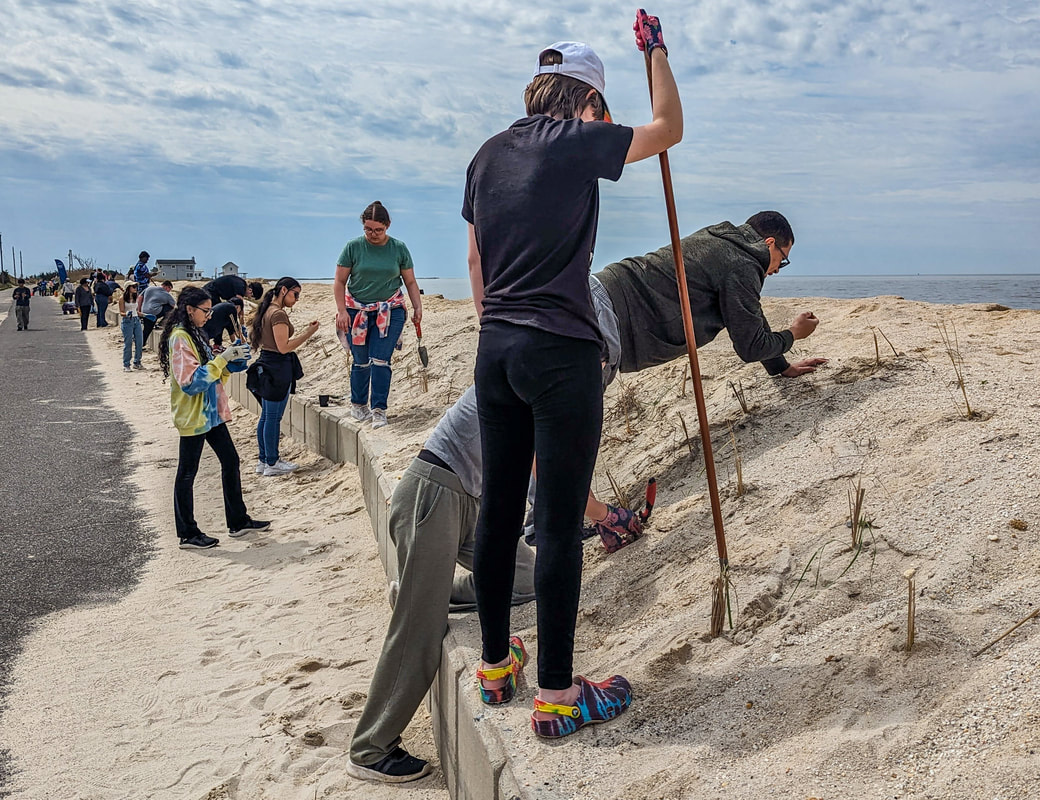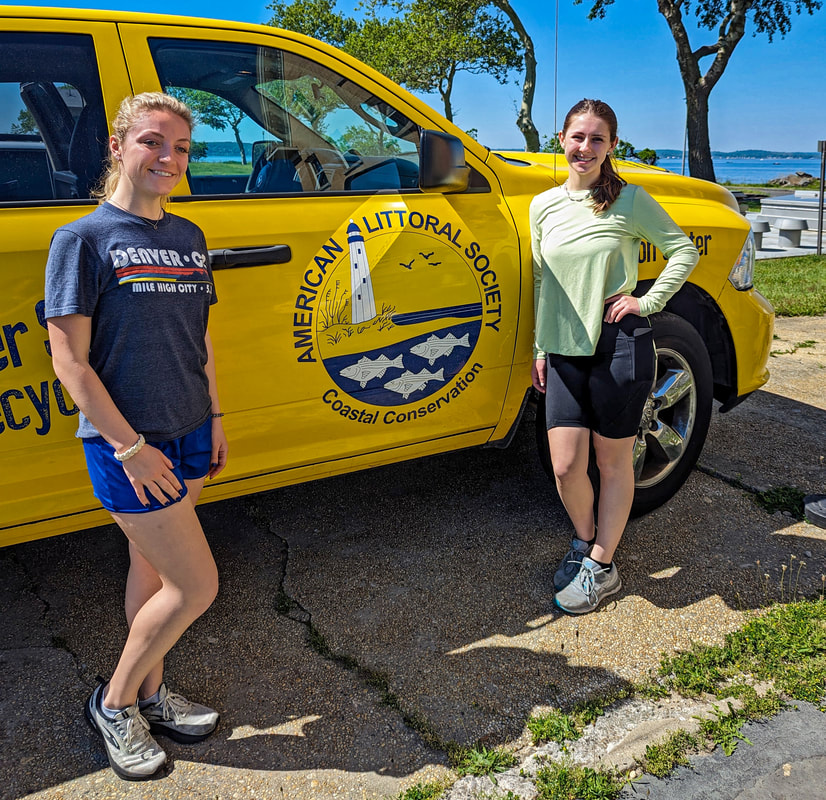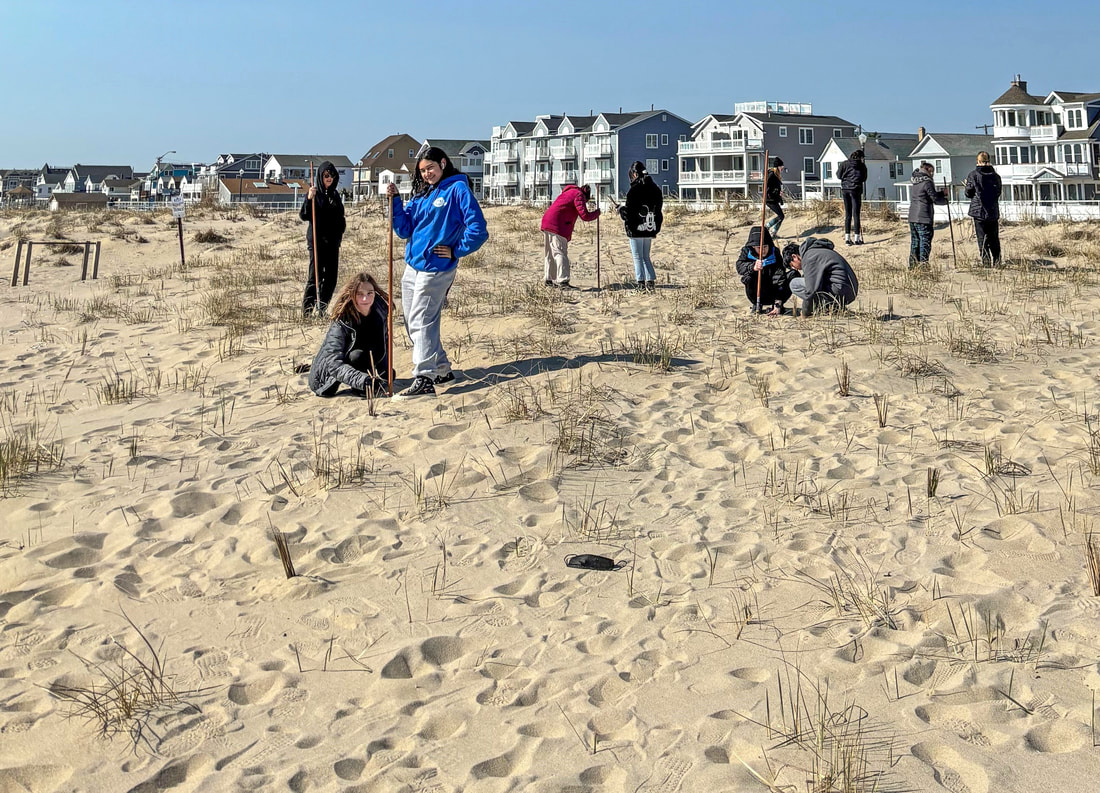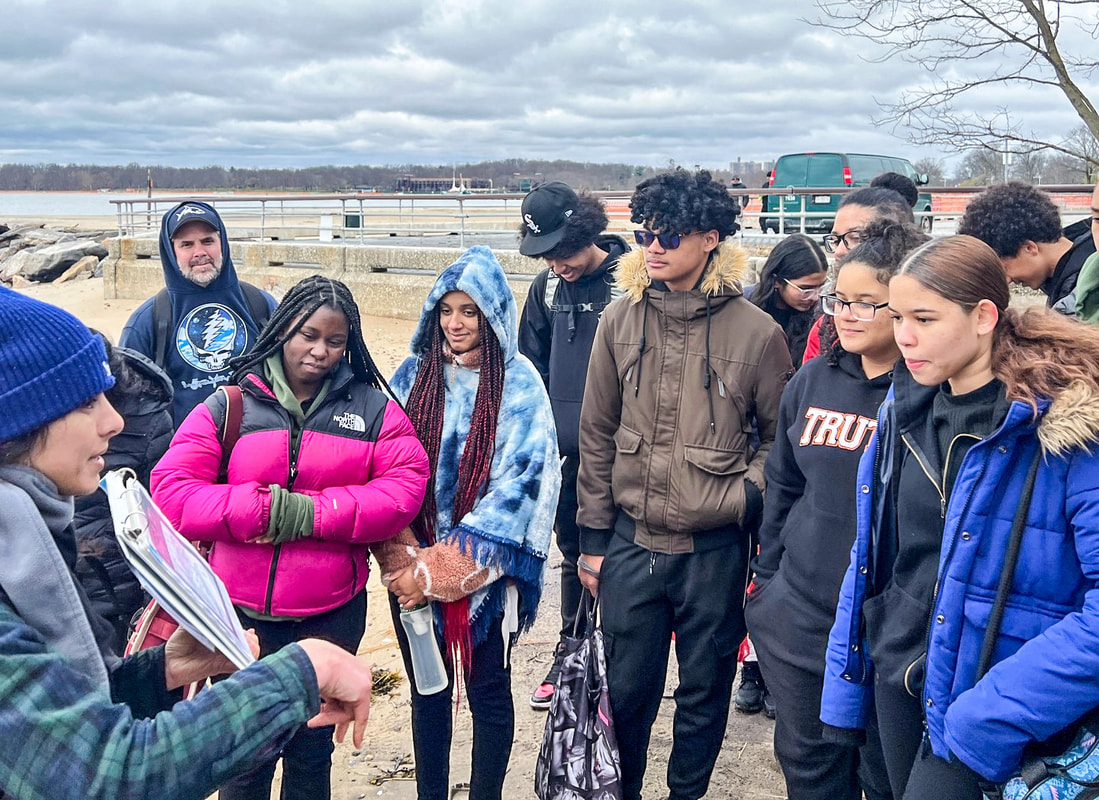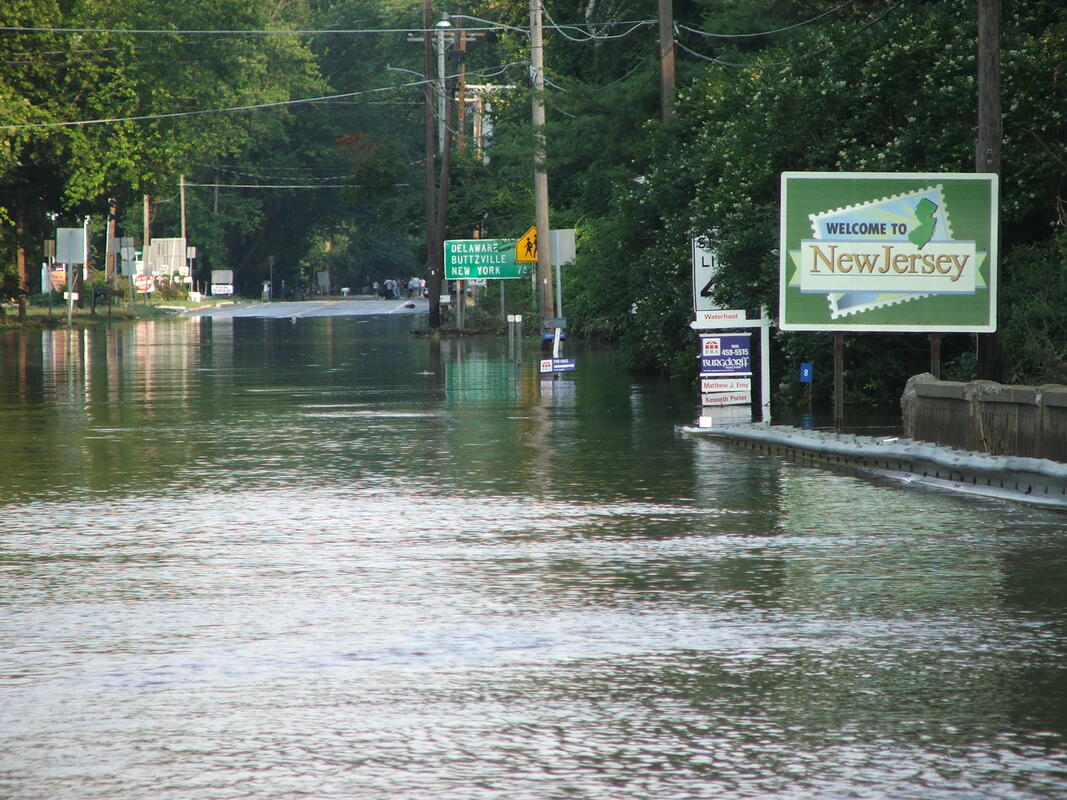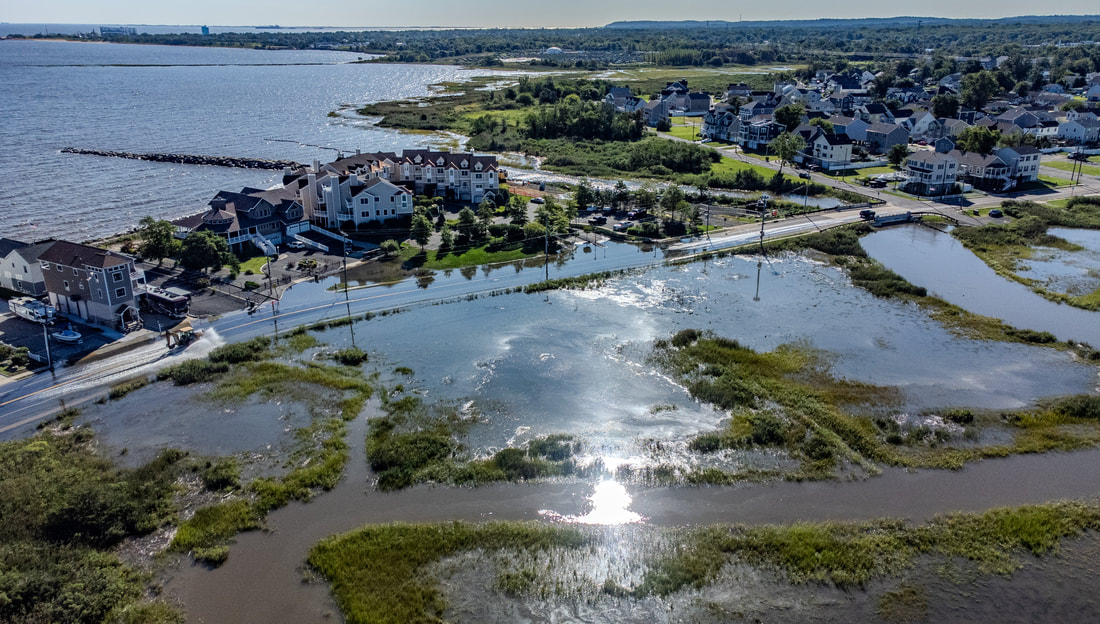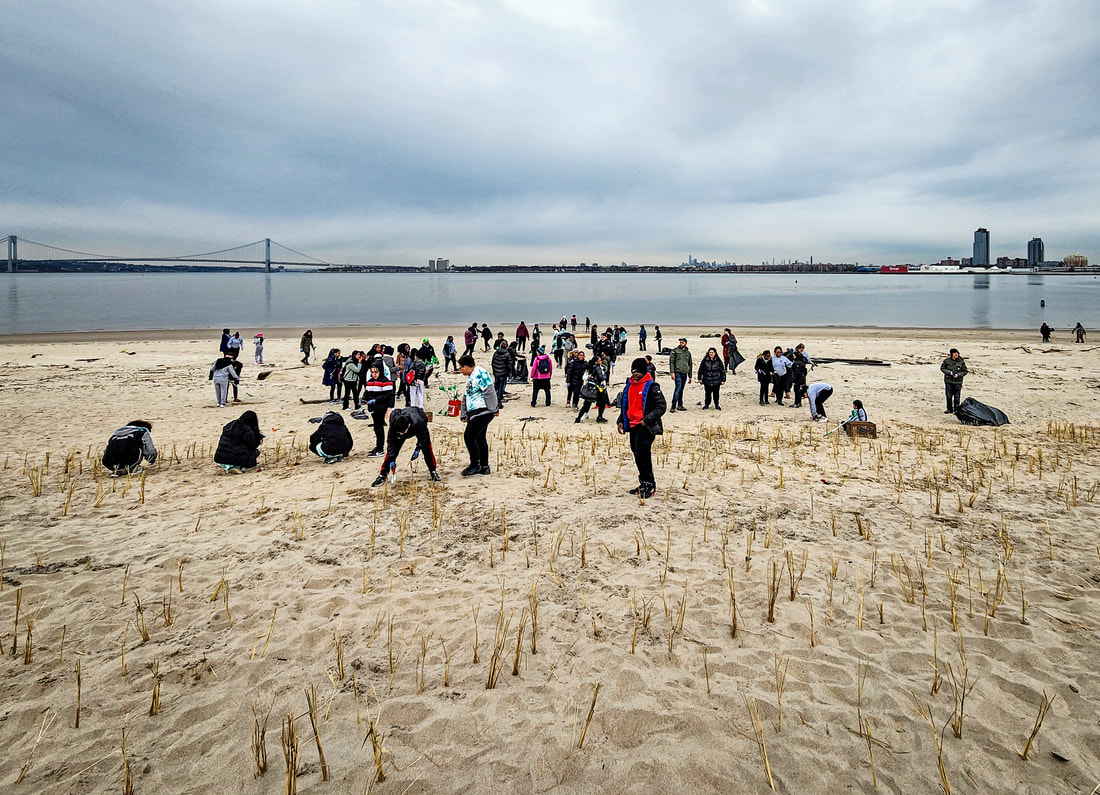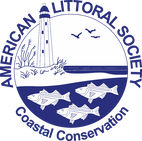|
Students from Vineland High School and community volunteers celebrated Earth Day with the Littoral Society by participating in a Delaware Bay dune grass planting at Fortescue Beach in Cumberland County. The Littoral Society recently completed a large-scale restoration project at this site to improve and protect this Delaware Bay beach for horseshoe crab spawning and migratory shorebirds. Thanks to the hard work of our volunteers, we planted 1200 culms of American Beachgrass to restore approximately 1000 feet of natural dune. The planted grasses will strengthen the dune system so it can provide flood protection to the neighboring community and vital habitat for wildlife. The student participants were a part of the Littoral Society’s Beach Grasses in Classes program. Prior to their beach visit, students received classroom lessons on the importance of coastal dune systems and their role in protecting communities from storms, erosion, flooding, and sea level rise. They also learned about American beach grass and its unique adaptations for survival in the harsh seaside environment. As part of the classroom segment, students also planted stems of beachgrass to care for ahead of their dune grass planting field trip. The class then visited Fortescue Beach to plant the grass they raised in their classroom in the natural dune system. Special thanks to the Vineland High School students who also hosted a t-shirt sale to fundraise a donation to the Littoral Society to support our work in the Delaware Bay region. An early season pair of horseshoe crabs leaving a nest - Slaughter Beach, DE By Trevor Metz, Littoral Society Delaware Seasonal Technician
What an exciting month! Extending the American Littoral Society’s advocacy and outreach to the great state of Delaware has been a fun-filled adventure over the past handful of weeks. As awesome as the experiences of bearing witness to moonlight horseshoe crab spawning and paddling alongside Red Knots have been, the overwhelming feeling is that we are at a pivotal time for protecting these vulnerable coastal species. I live in Milford, DE and only a short drive away from Slaughter Beach, one of the well-known shorebird stops along the Delaware Bayshore. The Mayor and Town Manager kindly set aside some time for me to introduce myself, explain the American Littoral Society, and talk about some of what we were planning in and around their town. I let them know about our interactive presentations, cooperative tagging efforts, and gave some insight into the Red Knot Fest that would be taking place Memorial Day weekend. The Littoral Society would like to welcome our new Coastal Education Interns, Stella and Samantha. Our Education Interns will be helping deliver educational programs to people of all ages on Sandy Hook. They’ll be getting their feet wet in the field of environmental education during our Close Encounters field trips, public nature walks, and special events all summer.
Please say “Hello” when you see them at Sandy Hook! Stella Mueller Bio I am so excited to be a summer intern with the American Littoral Society! I just graduated from the University of Rhode Island (URI) with a double major in Conservation Biology and Journalism. Recently, four students from an 8th grade science class at Howell Middle School South (Gavin, Sal, Brayden, and Ryan) completed a class project about the importance of dunes, protecting our shorelines, and how to communicate with adults and work together.
The project idea was all theirs, according to their teacher Danielle Gianelos, and drew on technical expertise provided by the Littoral Society's Habitat Restoration Director Capt. Al Modjeski. Their video for the project was submitted to the New Jersey Sustainable Schools Climate Contest. The Littoral Society’s Beachgrasses in Classes program was in full swing this winter and spring!
Beachgrasses in Classes is an incredible program that promotes community-based stewardship and helps students understand the important role that dunes play in protecting our coastline from storms and flooding. The Beachgrasses in Classes program begins with an interactive classroom lesson where students are introduced to dune ecology, American beachgrass, and the importance of both within the coastal ecosystem. The students then plant culms of American beachgrass in small cups and take care of them in their classroom for the next few weeks. In the early spring, students will bring their culms and plant them at a local beach, actively contributing to dune restoration. Recently, staff from the Littoral Society's Northeast Chapter and National Wildlife Federation took a field trip to Pelham Bay Park with students from the Comprehensive Model School Project 327 in the Bronx, NY.
The park is home to Orchard Beach, the Bronx's only public beach, which has 13 miles of shoreline featuring both fresh and saltwater marshes, along with woodlands, grass meadows and fascinating geology. The field trip was part of the school's continuing studies of Long Island Sound and designed to give students an opportunity to examine how the park’s diverse habitats are vital to both humans and wildlife. While there, the students explored the park’s rocky shoreline and tidal pools with Littoral Society staff, observing metamorphic rock and learning how the park’s geology was shaped by the Wisconsin Glacier during the last ice age. With guidance from the Long Island Sound Study - a bi-state (CT/NY) partnership consisting of federal and state agencies, and organizations dedicated to protecting the Sound - students tested the water quality of the Sound and observed Atlantic silversides, mussels, seaweed, and more that they caught with a seining net. Northeast Chapter staff will be participating in other related field trips during the month. Thanks to the curious students and amazing partners and teachers who made this a special day for everyone! In January 2020, New Jersey's Governor announced a groundbreaking policy designed to help protect the state's residents, infrastructure, coastline, and environment in the face of looming climate threats.
Four years later, those promises still haven't been turned into meaningful action. This is why a number of advocates and organizations - including the American Littoral Society - are once again urging Gov. Phil Murphy to finish what he started. “Governor Murphy has said he recognizes the dangers of climate change to New Jersey, but he needs to show that by fulfilling his 2020 promise to integrate climate science into planning and regulations that protect resident, communities and the environment,” said Lucia Osborne, Delaware Bayshore Program Director for the American Littoral Society. “We need to take unified action across the state to protect people and property from the threats of climate change; releasing the NJPACT rules is a crucial step.” In January 2020, in response to mounting scientific research, Governor Phil Murphy issued Executive Order 100, which directed the New Jersey Department of Environmental Protection (NJDEP) to adopt Protecting Against Climate Threats (NJ PACT) regulations. Read more on the Rules in the NJ Spotlight article here. 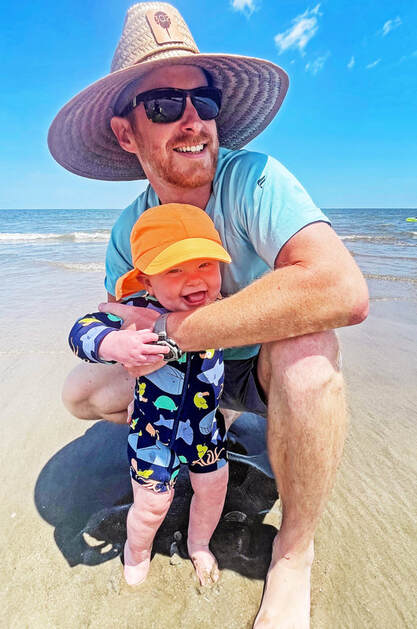 The American Littoral Society would like to introduce you to Trevor Metz, our new Delaware Seasonal Technician. Trevor will be responsible for bringing our horseshoe crab outreach to Delaware from now until the end of June. He will play an integral role in creating fruitful connections with the Littoral Society and our friends across the (Delaware) Bay, through community events and activities. We are so very pleased for this opportunity and are looking forward to meeting new people and talking with them about our work with horseshoe crabs and migratory shorebirds! In his own words: Greetings from across the bay! My name is Trevor Metz, hailing from Milford, DE, and a proud Blue Hen alumnus. Land use decisions in New Jersey are complicated now and likely to get even more difficult in the future. That's why the state needs an updated development plan.
New Jersey is the most populated state in the country, and it has a long coastline. NJ also has many state and local agencies working on real-world application of regulations and standards governing land use. All of that adds additional issues to balancing development priorities, which include affordable housing, urbanization, preservation of open space and natural habitats, economic development, and rising sea levels. While sea levels are rising around the globe, they are rising faster than average along the New Jersey coast thanks to things like subsidence, or the settling of the earth after groundwater is removed, and isostatic rebound, when melting polar ice reduces the amount of weight on certain parts of the earth’s tectonic plates. These factors create a see-saw effect, which lowers the ground elevation in places like New Jersey and raises it in places like Northern Canada. The net result is we’re losing marshland and increasing the amount of flood-prone areas, which means where we build is critical for the safety of humans and wildlife alike. Last but not least, NJ is on track to be the first state to reach "build out", meaning that every available parcel of land may soon be either developed or preserved. The Littoral Society's New York office recently received 13 boxes filled with American Beach Grass culms from Church's Garden Center in Cape May, NJ. The beach grass was generously purchased by the National Wildlife Federation in preparation for a series of planting events that will involve hundreds of students from communities across NYC. During the next few weeks, these grasses will be planted in partnership with NYC Parks and alongside 25 school teams coordinated by the National Wildlife Federation. The purpose is to make Coney Island a more resilient place for people and the nature. We are very excited to plant these grasses with students in order to restore and create more resilient shorelines in Brooklyn's Coney Island Creek Park. Safe to say that Don Riepe, the Littoral Society's Jamaica Bay Guardian, and Northeast Chapter Director Alexandra Kanonik will be sweeping up loose beach grass stems from the office for the rest of the Spring season! The American Littoral Society has been a partner on the National Wildlife Federations Resilient Schools and Communities program in NYC since 2020. In a related event, the Littoral Society's New York State Beach Cleanup Coordinator Jessica Klich led a pop-up St. Patrick's Day cleanup along Coney Island Creek ahead of the dune grass planting days. Big thanks to our intrepid crew of seven volunteers, who picked up a total of 245 pounds of trash! |
Archives
July 2024
Categories
All
|

